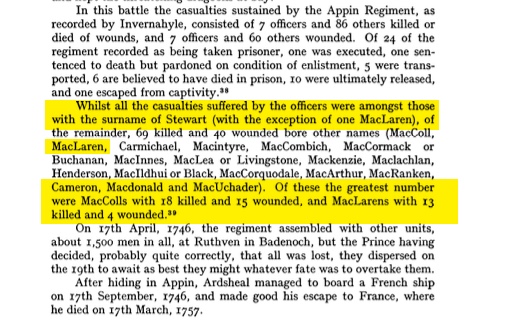There’s been a bit of controversy here and there as to whether Donald MacLaren was indeed a captain in the Appin Regiment or whether he belonged to a different regiment. There is sufficient documentary evidence in my opinion to support the assertion that he was part of the Appin Regiment and not the Atholl Brigade as some have claimed.
First, an article in the Journal of the Society for Army Research – A. McK. Annand, ‘Stewart of Appin’s Regiment in the Army of Prince Charles Edward, 1745-46‘, (Vol. 38(153), 1960. Page 24 and Page 27).
The entry reads: “Whilst all the casualties suffered by the officers were amongst those with the surname of Stewart (with the exception of one MacLaren), of the remainder, 69 killed and 40 wounded bore other names….Of these the greatest number were MacColls with 18 killed and 15 wounded and MacLarens with 13 killed and 4 wounded”. The MacLarens who were killed and wounded, however, may have been residents in Appin so not Balquhidder. I have found no evidence to support their residency.

Angus Stewart, in his article entitled ‘The Last Chief: Dougal Stewart of Appin‘, in The Scottish Historical Review, (Vol. 76(202), Edinburgh 1997, Footnote 41 on page 209): “There was a contingent of McLarens from Balquhidder with the Stewarts. This included Donald McLaren of Invernenty, listed as captain in the Order Book of the Appin Regiment and celebrated for an audacious escape from captivity in the aftermath of Culloden. An old blood tie is the usual reason given for the alliance, it may also be significant that Appin gave Invernenty credit and thereby acquired title in 1748 as a secured creditor in the ranking of his creditors (service of heirs, SRO, C22/95/24)….”
This ties in nicely with a couple of things. First, the blood tie. Margaret MacLaren’s history of our clan and several Stewart family histories detail the marriage between the daughter of the Chief of MacLarens of Ardveich and John Stewart. A previous liaison between the two had produced a son, Dugald. After John’s first wife died he sent for the MacLaren woman (whose first name I’m still searching to find) and Dugald (18 at the time) with the intent to marry her and declare Dugald his legitimate heir. He had no male issue from his first marriage.
The powers that be in the Stewart clan weren’t too happy about this as they stood to lose any claim to the throne so-to-speak. So they set about to have John killed. The idea being to see him dead before he could wed MacLaren and make his bastard son a legitimate heir. So they set about hiring an assassin to stab John Stewart. Happily for MacLaren and son, John, in spite of life threatening injuries managed to hang on long enough to say ‘I do’ and declare Dugald his heir; basically dying at the alter.
Unfortunately, at 18 and without a great deal of support, Dugald was unable to fend off his relatives and he was forced to relinquish his claim and departed for another part of Scotland where he went on to found the Appin Stewarts.
That blood tie with the MacLarens was held and enforced across the centuries as the two clans went to each other’s aid when required. (See Henry Lee, History of the Stewart Family, New York: 1920, p. 36 onward and Margaret MacLaren, The MacLarens, p. 31)
This is nicely supported by Donald’s son, James, who sued the Stewart family after Dugald Stewarts’ death in an attempt to gain back the lands his father assigned to Dugald after the uprising of ‘45. In his Memorial – which more or less equates to what we would call a deposition today – he says: “…He [Donald MacLaren] owed sundry debts to several persons, particularly to Dugald Stewart of Appin, who was his connection and confidential friend, who was a man of considerable influence in that part of the country, and who had taken the memorialist’s father, as being one of his followers, under his protection and friendship.” Here is a copy of that passage.

Further, on page 142, listing number 2234 in the Prisoners of the ’45, Vol. III by Seton and Arnot, we find another reference to Donald MacLaren identifying him as a Captain in the Appin Regiment.

Finally, there is a listing in the Atholl Chronicles, Vol. III wherein Donald is listed, again, as a Captain in the Appin Regiment on page 300. As these are taken directly from the original records of the Duke of Atholl it seems pretty unlikely that he would have written that MacLaren was an officer in the Appin Regiment if he was an officer in the Atholl Brigade.

All-in-all it looks to me that the preponderance of evidence strongly supports the argument that Donald was, in fact, an officer in the Appin Regiment during the course of the Jacobite uprising in 1745-46.